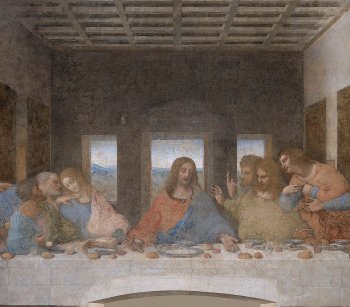Passover with the Parents
Our first of six New Testament Passovers revolves, surprisingly, around a young Jesus.
Jesus, born in the fall of 5 B.C., was twelve years old in the spring of 9 A.D. The Passover that year ran from sunset March 29 (Friday) to sunset the next day. The First Day of Unleavened Bread that year, which began at sunset on Friday, was extra-special as it was not only a Biblical High Day but also the weekly Sabbath.
Now His parents went to Jerusalem every year at the feast of the Passover. And when He was twelve years old, they went up to Jerusalem according to the custom of the feast (Luke 2:41 - 42, HBFV throughout).

This Passover marks the first time in Scripture it is revealed that, even at a young age, Jesus was fully aware of his divine birth and that God, not Joseph, was his true Father. He comprehended that his purpose was not to become a carpenter like his stepfather but rather to fulfill God's will for him.
Why is it that you were looking for Me? Don't you realize that I must be about My Father's business? (Luke 2:49).
Cleansing the Temple
This first Passover during the Lord's earthly ministry took place in 27 A.D. Just before its arrival the Lord seizes the opportunity to cleanse his Father's house of the dishonest sellers and moneychangers within it.
Now the Passover of the Jews was near, and Jesus went up to Jerusalem.
And He found in the temple those who were selling oxen and sheep and doves, and the money exchangers sitting there; And after making a scourge of cords, He drove them all out of the temple, with both the sheep and the oxen; and He poured out the coins of the money exchangers, and overturned the tables (John 2:13 - 15).
The Lord's display of righteous indignation introduces his teachings and ministry to a huge audience (see John 2:23). It also marks the first time in the New Testament that Jewish leaders begin to show their resistance to him and his message (John 2:18 - 21).
Defending the Disciples
The second Passover of Jesus' ministry, in 28 A.D., is strongly hinted at when he defends his disciples against the ridiculously petty criticisms of the Pharisees.
Now it came to pass on the second Sabbath of the first rank that He was walking through the grain fields; and His disciples were plucking the ears and were eating, after rubbing them in their hands. But some of the Pharisees said to them, "Why are you doing that which is not lawful to do on the Sabbaths?"
And Jesus answered and said to them, "Have you not read even this, that which David did when he himself hungered, and those who were with him? . . . The Son of man is Lord even of the Sabbath" (Luke 6:1 - 3, 5).
The phrase "the second Sabbath of the first rank" refers to the last day of Unleavened Bread in 28 A.D.
"The Sabbaths of the first order or rank are annual Sabbaths, which take precedence over the weekly Sabbath. Luke is clearly recording that Jesus and the disciples were going through the grain fields on the second annual Sabbath, which was the last day of the Feast of Unleavened Bread" (Holy Bible, a Faithful Version comment on Luke 6:1).
The Feast of Unleavened Bread immediately follows the keeping of Passover.
Feeding 5,000+
Jesus' third Passover is mentioned directly only in the gospel of John.
Now the Passover, a feast of the Jews, was near. And when Jesus lifted up His eyes and saw a great multitude coming toward Him, He said to Philip, "How shall we buy enough loaves to feed all these?" (John 6:4 - 5).
The Lord, after posing his question to Philip, proceeds to miraculously feeding more than 5,000 people! This awesome miracle, other than its sheer scale, is unique in that it is one of only seven the Apostle John records. It also left such a huge impression in the minds of the disciples and the public that it is Jesus' only miracle listed in all four Gospel accounts (Matthew 14:13 - 21, Mark 6:30 - 42, Luke 9:10 - 17, John 6:1 - 13).
The Last Passover
Jesus' fourth and last Passover, the fifth of six mentioned in the New Testament, was observed just before he was arrested, tried and crucified (Matthew 26, Mark 14, Luke 22, John 13).
Chastising the Corinthians
God's annual Holy (Feast) Days continued to be kept by Christians long after the death of Christ. One outstanding example of this fact is found in 1Corinthians written by the Apostle Paul in 56 A.D. It is our sixth of six Passovers found in the New Testament.
One of the many issues Paul tackled in his first letter to the Christians in Corinth was their improper observance of the Christian Passover.
Therefore, when you assemble together in one place, it is NOT to eat the Lord’s supper. For in eating, everyone takes his own supper first; now on the one hand, someone goes hungry; but on the other hand, another becomes drunken . . . (1Corinthians 11:20 - 21).
The Corinthians had erroneously added a meal to the Christian Passover service. They were then treating what was meant to be a yearly solemn assembly to remember the Lord's death (Luke 22:17 - 19) like a frat party with enough alcohol to get people drunk!
Paul had to rein in the Corinthians by reminding them their purpose in meeting was NOT to eat a meal. It was to partake of the New Testament Christian Passover with the simple but profound symbols of unleavened bread and wine. His authority for such a practice was Jesus' own words and actions during his last Passover (1Corinthians 11:23 - 26)!